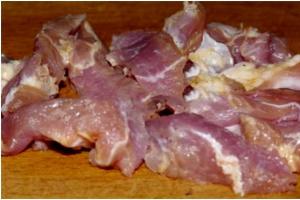Below we list the pros and cons of using the technology of building houses from SIP panels.
Advantages:
- due to the high heat-saving characteristics of enclosing structures.
- More usable area - due to the small thickness of the walls, you can get 15-20% more usable area.
- Accelerated installation of the box at home (1-2 weeks).
- There is no need to construct an expensive foundation (for example, one installed in 1 day is sufficient).
- Saving on heavy lifting equipment can significantly reduce construction costs.
- You can build houses all year round- they do not shrink, so finishing work can begin immediately after assembly.
- The assembly technology is simple, you can even build a house from a SIP panel with your own hands - anyone who follows the instructions and knows how to hold a screwdriver and a saw can do this.
Flaws
- A slight thermal inertia of the enclosing structures is typical of any frame houses.
- The high price of the material - however, this is more than offset by savings in foundation costs and a reduction in construction time.
- Enclosing structures do not breathe, and, therefore, an efficient device is necessary - this drawback is also inherent in all frame houses.
- The flammability of enclosing structures is no higher than that of any wooden buildings.
- The release of harmful substances during combustion - indeed, when polystyrene foam melts, styrene is released with a specific sweetish odor. When its concentration in the air is more than 600 ppm (1 ppm = 4.26 mg/m3), it is dangerous to humans. But the smell of styrene becomes unbearable even at concentrations above 200 ppm, and this is an unambiguous signal for urgent evacuation.
- Suitable for rodents - although these animals are bred anywhere, there are known cases when rats even gnawed through concrete in search of food.
How to choose SIP panels
Structural Insulated Panel (SIP), or structural insulating panel (SIP), is universal for walls, ceilings and roofs of low-rise residential buildings. It is three-layer, consists of facings (two moisture-resistant oriented strand boards - OSB) and a core (expanded polystyrene sheet), glued together under pressure polyurethane glue.
Standard panels have a height of 2.8 or 2.5 m (with a width of 1.25 m) - they are used for the walls of the first and second floors, respectively. With classical technology with platform floors, the height of the panel is equal to the height of the rooms without finishing. However, if the house is planned duct system ventilation, air conditioning and air heating, and the floors are on joists, then the ceilings will drop by 15-20 cm. Therefore, it is advisable to order panels 3 m high for the first floor (alas, only some companies make them), and for the second - 2.8 m.
Products are produced in thicknesses of 224 (12 + 200 + 12), 174 (12 + 150 + 12) and 124 (12 + 100 + 12) mm. The first ones are used to build floors and roofs, the second ones are middle lane Russia are optimal for external (as well as internal load-bearing) walls, while others are suitable for.
There are also cheaper products on the market with linings 9 mm thick, but they are only suitable for walls and partitions of small one-story buildings.
Differences between a factory SIP panel
- Inaccurate geometry. The shift of the plates relative to each other, the diamond-shaped or trapezoidal shape of the panel are easily identified using a square and a tape measure.
- Use of low-quality OSB with low moisture resistance. Wet the surface of the panel generously for an hour or two. If the chips begin to peel off, you have a defective product.
- Low strength adhesive connection. This is perhaps the main feature of goods produced in a semi-handicraft way. The product can only be checked by tearing off one of the coverings from the insulation. High quality panel It breaks not along the seam, but along the foam sheet.
- Making the middle part of the panel from fragments polystyrene foam boards. To reduce the amount of waste, handicraft enterprises use cuttings of insulation, which negatively affects both the strength and the heat-insulating properties. The joints of polystyrene foam boards are easy to see at the ends of the panels.
Step-by-step construction of a house from SIP panels
Foundation
Companies that build houses from SIP panels recommend making one that fully meets the concept of a prefabricated building. Piles for a house with an area of up to 150 m² can be installed in two to three days, and with the help special installation- for one day; Assembling a grillage from a channel or timber frame will also not take much time.
The force of frost heaving is many times greater than the load from light walls made of SIP panels. In such conditions, piled and insulated shallow foundations work best.
(their most common diameter is 108 mm, length - 2.5 and 3 m) are placed under external and internal main walls, as well as crossbars (they are needed to reduce the span of beams) in increments of 1.5–2 m. Such a base leads well itself on heaving soils and practically does not settle under light walls - provided that the laying depth was determined not randomly, but as a result of test screwing with force measurement: the blades of the piles should rest on dense layers of soil.
To last for more than 50 years, you need to purchase steel piles with a thickness of at least 4 mm with cast tips, which resist corrosion much better than welded ones; After installation, they should be filled with concrete. One support, including installation, will cost 2,400–2,700 rubles, that is, the cost of a foundation for a house measuring 8 × 10 m will not exceed 100 thousand rubles. True, finishing the basement will require additional costs: you will have to install cement-bonded or glass-magnesite sheets (for facing with tiles or stone) or decorative panels on the frame.
The main alternative to a pile-screw foundation is traditional for country house construction a shallow-buried strip 0.3–0.4 m wide and 0.6–0.8 m high. If you prepare concrete yourself rather than buy it at a factory, such a foundation will cost slightly less than a pile foundation, but the construction time will increase by at least 3 weeks . The key to the reliability of a strip foundation is a properly executed reinforcement cage; it should be designed in accordance with SP 63.13330.2012 (the main requirements are the presence of at least two reinforcing chords and a reinforcement coefficient of at least 0.1%). The base of this foundation cannot be erected on heterogeneous soils with quicksand. The lightweight one is optimal for swampy areas with highly heaving and weak-bearing soils. The slab is poured on top of a sand and gravel drainage pad, a layer of extruded polystyrene foam at least 100 mm thick and a waterproofing substrate. The minimum thickness of the slab is 200 mm, and it must be reinforced with a two-level frame made of rods with a diameter of 12 mm. To protect the walls from water (mainly melt water), it is worth erecting a reinforced concrete plinth 0.3–0.5 m high along the contour of the slab. It is advisable to insulate the blind area and the plinth with 50 mm thick EPS sheets.
It is advisable to strengthen the foundation made of steel piles with a grillage made of a channel or I-beam. The grillage rand beams must be welded to each other and, in addition, welded to the piles. Metal parts must be protected from corrosion and isolated from the wooden frame with rolled waterproofing.
When installing a floating strip foundation, there is no point in going deep into clay soil - it is better to build up the above-ground part, which will serve as a plinth. The reinforcement frame should be knitted with galvanized wire. The connections must be strong and durable, because the frame must work as a single unit throughout the entire service life of the foundation.
Walls
Despite the fact that the technology is considered unified, each company and even team has its own methods of assembling enclosing structures - successful and not so successful.
Construction requires products of both standard and non-standard sizes - lintels over openings, partitions, roofing elements, etc. Large companies with their own production line carry out cutting only in factory conditions. Small firms and “autonomous” teams often cut out the necessary fragments on site using circular saw and a foam grater (using this tool to select grooves along the perimeter of the panels). With this method, there is a high risk of violating the geometric dimensions of rooms and openings, and the appearance of gaps at the joints of parts.
The construction technology involves the installation of a hidden frame, the parts of which are inserted into the grooves of the panels. For the frame, select chamber-dried lumber should be used, impregnated with an antiseptic composition, and for floor beams it is advisable to use either a wooden I-beam. Alas, sometimes under-dried products are used, which can warp, which will lead to the appearance of cracks and deformation of walls and ceilings. The junction of panels with frame elements is always sealed with polyurethane foam. However, some teams are accustomed to assembling racks from two boards, simply tightening them with screws without any sealing of the seam. In this case, 150 × 100 mm timber can be installed in the corners. It seems that this should increase the strength of the frame of the house, but in practice such a solution only guarantees freezing of the corner in the harsh winter.
Roof
An attic or semi-attic floor can be built using SIP panels or traditional technology with insulation mineral wool or other materials.
Sometimes you can hear that a roofing cake based on SIP panels is more resistant to moisture (after all, expanded polystyrene has extremely low water absorption). However, the constant presence of moisture (which can seep through roof covering or coming from below in the form of steam) leads to the destruction of panel coverings (OSB). In addition, at temperatures above 80 ° C, the process of thermal destruction of expanded polystyrene begins.
Therefore, it is necessary to provide a ventilation gap between the SIP panels and the roofing material. You can’t do without a layer of vapor barrier on the side of the premises, as well as a ventilated ridge.
The load-bearing part of the roof made of SIP panels includes a ridge beam, purlins (bearing beams parallel to the ridge) and layered rafters, the function of which is performed by the beams between the panels. Installed panels covered with a continuous carpet of rolled vapor-permeable waterproofing, then a slatted sheathing is installed, to which a roofing covering (for example, profiled steel sheets) or another layer of OSB is attached, which serves as the basis for flexible bitumen shingles.
Air handling unit should be placed in a soundproofed room: the noise during its operation reaches 45 dB. From installation in risers, behind false ceilings and inside the ceiling, air ducts are laid - usually of a circular cross-section with a diameter of 100-150 mm.
Forced ventilation for a house made of SIP panels
SIP panels insulate heat well, but are not able to accumulate it. As a result, the so-called thermos effect occurs in the house: after airing the room, the outside coolness remains for a long time. And you have to ventilate regularly, since in sealed rooms the air quickly becomes saturated with moisture and carbon dioxide. As a result, the benefits of using effective insulation are greatly reduced, and fluctuations in temperature and humidity create discomfort.
Drastically change the situation in better side is only capable of coercive system supply and exhaust with heat recovery, which will provide zonal air exchange. The main element of such a system is a recovery unit. For a cottage with an area of about 120 m2, where a family of three or four people lives, an installation with a capacity of 180-250 m3/h is sufficient, the price of which will be 60-250 thousand rubles. depending on the design and manufacturer. The cost of the system with installation varies between 350-700 thousand rubles. without taking into account the costs of creating hidden cavities for laying ventilation ducts.
Finishing of SIP panels
In the vast majority of cases, the inside of walls made of SIP panels is sheathed with plasterboard, sheets of which can be attached directly to the internal OSB. The sheathing is made of two layers, providing channels for electrical wiring in the first layer (the cables must be placed in protective corrugated pipes or PVC boxes). With the traditional method of installing gypsum boards (using lath or steel sheathing), pipes and cables are laid in cavities under the sheathing.
Most often mounted outside curtain façade. In addition, plastering is possible, but in order to avoid cracks it is advisable to use technology wet facade, with , wooden planks, composite panels.
Reading time ≈ 4 minutes
The technology of building houses from SIP panels has been used for several decades in North America. Such construction is also common in Europe. The popularity of this technology is due to the reliability of the design, high speed of construction regardless of weather conditions, and good heat-protective properties. The ease of assembly makes it possible to build a house from SIP panels with your own hands without the involvement of a large team and heavy equipment.
Features of this technology
You can be convinced that this type of construction is feasible by looking at the photo report below on the construction work carried out. The information below shows how to build a house from SIP panels yourself.

For complete clarity, it should be noted that the concept of SIP panel came from in English- SIP (Structural Insulated Panel) translates as structural insulated panel (see photo).

Houses made from such sandwich panels cope with both lateral loads (hurricane winds) and the weight of snow on the roof.
The main stages of building a house from SIP panels

If construction is planned on land where there was nothing previously, the placement of a house on the site will be associated solely with the personal preferences of the owners, and with the placement standards regarding land boundaries. If there is a pipeline nearby, they are equipped sewage, care must be taken not to damage communications during the construction process.
Markings are made for the foundation.


Construction of the foundation
The light weight of a house made of sandwich panels allows you to minimize the cost of building a foundation. A massive structure is not needed here. Lightweight buildings made from SIP panels can be placed on the following types of foundations:
- tape;
- pile-screw;
- slab

Of course, you can equip the basement floor.
Here it was decided to build a house without a basement. First, with the help of heavy equipment, they equipped the site and made a small deepening under the foundation. When the recesses are made according to project documentation, arrange the formwork and fill it with concrete mortar.


Cinder blocks are installed on the strip foundation, which are reinforced and filled with concrete.




In this situation, 988 blocks were used. It turns out to be a rather high base of the house. This helps protect your home from moisture and insects. Instead of cinder blocks, you can simply use concrete to fill the base.
Arrangement of the lower level

SIP panels are considered to be very durable. You can easily find a video of a truck driving over such a panel, and it does not deform at all. Therefore, the floor in the house is made from this material. Only first, waterproofing is laid on the foundation. The first panel is placed on it, aligned with the corner of the foundation. The joints between the panels are filled with foam. A connecting key is also installed there. The second panel is attached close to the first. The connecting dowels to which the panels themselves are screwed will add rigidity to the entire structure.



When laying panels, you need to check the level. If there are deviations, they must be eliminated. The end part of the laid panels is covered with strapping boards; foam is used to fasten them. As a result, the floor of the first floor will externally resemble a monolithic panel.
Laying communications
Pre-prepared technological holes are used for laying communications. This is both a water supply system and a sewerage system.



This work must be carried out before laying the finished floor.
Arrangement of internal partitions

Typically, internal partitions are installed simultaneously with the structure load-bearing walls.


But if there are delays in the delivery of panels, you can install the frame first internal partitions in accordance with the diagrams and drawings of the design documentation.
Installation of SIP panels

The main stage of building a house from SIP panels with your own hands is the installation of the panels themselves.



fasten this material it must be without gaps and voids. The more airtight the connection, the more comfortable it will be to live in the house. The joints need to be filled polyurethane foam. Fastening is carried out with self-tapping screws. It is better to secure the panel to the guide beam on the foundation with anchor bolts to eliminate possible shifts during shrinkage of the foundation. The number of joining seams should be minimal. That's why best option- construction of a house from SIP panels made specifically for a specific project.




When the walls of the first floor are assembled, timber and floor panels are laid.





Roof construction


The Mauerlat is made, a rafter system is installed, on which SIP panels are installed, and the roof is already attached to it. You can see in detail how the roof is installed
Residents of Europe and North America For more than fifty years, they have been using structural heat-insulating sip panels to build strong, warm, durable and environmentally friendly buildings. IN Lately houses built according to Canadian technology, have become popular in our country. Today, a large number of construction companies offer their services for the construction of such buildings. Of course, you can hire representatives of one of these many companies for construction, however, you can make a house from vulture panels with your own hands. Self-assembly will significantly reduce the cost of 1 m 2 of a building, without damaging its quality.

Homes from sip panels have many advantages, however, we will highlight the most significant of them:
- Buildings are distinguished by a high degree of thermal insulation, so the cost of heating buildings made from structural insulating sip panels is significantly lower than the cost of heating wooden, concrete or stone houses.
- Good sound insulation guarantees reliable protection from external noise.
- Structures of this type have an increased margin of safety and long term operation, which can exceed 100 years.
- Thanks to simple principle connections, houses are assembled very quickly, while perfectly smooth walls and corners lend themselves very well to finishing.
- The probability that this design will shrink, very little.
- The material from which the vulture panels are made is not subject to rotting and is not affected by insects. In addition, the material does not contain harmful substances that can harm the health of residents or cause damage to the environment.

Canadian technology is equally successfully used for the construction of real estate of any type. Today, the following are built from sip panels:
- Country houses, country cottages.
- Office buildings.
- Hotel complexes, tourist centers.
- Restaurants, bars, cafes.
- Warehouses, workshops and much more.
Preliminary work
The first thing you need to do before starting construction is to draw up a project for your future home. If you can’t create a project yourself, you can resort to the help of specialists. In addition, it is permissible to use standard projects, which are presented on various Internet resources, or adapt these projects to your requirements, making the necessary adjustments.
- Equally important is the acquisition the necessary tool. At the same time, it is strongly recommended to refuse to purchase a low-quality instrument, because this can lead to various unpredictable negative consequences.
- Strict adherence to safety rules will keep your health intact and help you complete your work efficiently and on time. construction works in full.
Construction stages

- The construction of a foundation is a mandatory initial stage in the construction process of any building or structure. A house made of vulture panels has a relatively light weight, so in most cases it is advisable to build a foundation on screw piles for such a building. The advantage of this type of foundation is that its construction takes no more than two days, while installation work possible even with negative temperature air. Another positive aspect of using a foundation on screw piles is that its cost is quite low compared to the cost of building other types of foundations.
- After completing the work related to the construction of the foundation, you should proceed to its waterproofing. To do this, use roofing felt, which must be laid in two layers.
- Next, you need to lay the strapping beam, which will serve as the base for the floor. Laying is carried out on the heads screw piles according to previously created drawing documentation.
- At the next stage, panels are installed that act as flooring. Waterproofing is provided by a layer of bitumen mastic applied to their outer side. They must be laid out along the entire perimeter of the future structure and joined in width and length by connecting to the strapping beam using a strong and invisible tongue-and-groove connection. Before the splicing process, each groove is treated with a one-component polyurethane foam sealant. Additionally, screws that need to be screwed into each side of the connection help secure the structure. When the floors are finally assembled, a one-component polyurethane foam sealant should also be applied to their ends, after which the outer parts are sheathed with wooden boards.
- After completing the above steps, you can begin to assemble the walls of the first floor of the house. First of all, it is necessary to install the horizontal frame of the walls along the foundation, i.e. lower wall trim. In this case, the work must be carried out with special care, strictly adhering to the installation diagram, from which one cannot deviate. Any inaccuracies on at this stage construction can lead to serious problems in the future. You can install sip panels that will serve as the walls of the building when you are ready bottom harness. First, the corner elements are installed, after which the remaining racks and slabs are fastened (installation is carried out from the first corner panel and is carried out in two directions, to the second corner element). During the assembly process, each newly installed slab must be monitored with a special measuring tool - a building level, which makes it possible to determine the amount of deviation from the vertical or horizontal line and, if necessary, correct its position.
- After this, the upper samples are treated with a one-component polyurethane foam sealant, then the upper trim is laid.
- Next comes the installation of the interfloor slab. To do this, slabs with a layer of one-component foam pre-applied on them are mounted on the panels of the first floor along the entire perimeter of the building. polyurethane sealant, acting as an interfloor ceiling (as well as on the first floor).
- The wall panels of the second floor are mounted and fastened together in the same way as wall slabs first floor of the building. Sometimes the spans of rooms may have big sizes. In this case interfloor ceilings it is best to reinforce it with laminated veneer lumber (LVL lumber), which can later be hidden using decorative finishing of the ceiling, under plasterboard sheets or under a suspended ceiling.
- Roof installation work is the final stage of building a house. It should be noted that the construction of the roof is carried out without rafter system, because sip panels have a significant margin of safety, thanks to which they are able to withstand high external loads. The principle of connecting roof slabs remains the same as the principle of connecting floor panels. In this case, there is no need to use vapor barriers and waterproofing materials, because the material has good vapor barrier and heat insulating properties.
- After the roof is erected, you can begin to install the roof covering, which can consist of any roofing materials, there are no restrictions in this case.
- Window openings can also have any shape and size.
- Showing into the house engineering communications can be carried out in parallel with interior finishing work.

Construction from sip panels (SIP) can be considered the fastest that currently exists in this market. It’s quite possible to build it in a week or a week and a half one-story cottage. The technology came to us from Canada. It is also extremely popular now in European countries.
Buildings made from sip panels are very warm and quite reliable. In our conditions, the material is ideal for the construction of country cottages and country houses. In this regard, many who want to become owners of such temporary or permanent housing are interested in how to build a house from sip panels with their own hands in record time due to technology.
What are sip panels?
Sip panel is a three-layer building material. Interior– a thick layer of expanded polystyrene, which acts as an insulating and insulating material. On both sides, 2 layers of chipboard OSB are attached to it. It is made from wood chips, multi-directional and glued under pressure.

Expanded polystyrene provides excellent sound and heat insulation. OSB boards and high-quality glue produced using special technology reliably fix insulating material. During construction, sip panels are connected to each other with polyurethane foam, and wooden beams give rigidity to all structural components.

Advantages of this building material:
1. Durability - 100 years or more.
2. Fast construction using the joining method of SIP panels.
3. You can build in any season, since there are no solutions that require special conditions for hardening.
4. Very simple design roofs.
5. Thanks to the small thickness of the panels, the usable area inside the house increases.
6. A building built using this technology is very light and does not shrink.
7. Excellent thermal insulation, allowing you to save energy even during the heating season.
8. Easy installation of doorways.
9. Perfectly smooth and Smooth surface panels allows you to use any finishing without preliminary leveling of the walls.
10. Expanded polystyrene and OSB boards do not rot; Rodents do not live in them.
11. The material is absolutely clean and environmentally safe.
12. Construction from it is quite simple and does not require the involvement of heavy construction equipment (cranes, etc.) in the process.
13. Low prices for SIP panels make construction from them the most cost-effective option.
Flaws:
1. The panels do not allow water vapor to pass through, so buildings made from them need high-quality ventilation.
2. The material cannot boast of high fire resistance. In this regard, the issue of electrical wiring insulation needs to be given Special attention. It is recommended to install a fire alarm.
3. The material is not resistant to moisture, so the foundation must be made wide enough to protect the structure from dampness.
4. The technology for constructing houses from sip panels does not allow for much diversification of standard projects.
Construction from sip panels (video)
You should always start with design. And although you cannot expect much variety in this matter, it is important to correctly calculate the size of the rooms, the placement of communications, etc. The complete assembly of the building is shown in the video.
A building made from sip panels is very light weight and does not require a powerful foundation. Under one or two-storey house you can build a strip or pile-screw. During the construction of the foundation, it is very important to properly waterproof it. This will require bitumen mastic and 2 layers of roofing felt, the sheets of which need to be overlapped.

Then you can begin laying the subfloor, which we also build from the same SIP panels (video). The photo shows how the floor is attached to the foundation. The panels are connected to each other and immediately fixed using polyurethane sealant and self-tapping screws.
Building walls (video)
You can see what the assembly of building walls from SIP panels looks like in the video.
It is assembled literally like a large construction set. First, the lower trim is installed. As is the case with many modern building materials, construction from sip panels begins from the corners of the house. Subsequent ones are attached to the corner panels, butt to joint, in both directions, up to the next corners. A wooden beam is laid between the panels, fixed with sealant and self-tapping screws.

To build any building, you must use building level. In this case, this is also relevant, despite the fact that the sip panels are perfectly smooth. Using a level will help prevent walls from deviating from the ideal vertical. The ends of the walls and the upper sections are covered with sealant, after which we begin to make the upper trim.

To create floors between floors, the same sip panels are used. They have sufficient strength for this and can withstand very significant weight (furniture, the residents themselves, etc.). After installing the floors, we continue to build walls - now on the second floor. The ceilings are reinforced with wooden beams.

Door/window openings are made very simply: they can simply be cut using a regular hacksaw. The material lends itself perfectly to processing and requires almost no effort during this process. All this can be done with your own hands.
How to build a roof
The technology for constructing a roof on such a building is extremely simple. To build it, we again use the same SIP panels. The slabs are mounted according to the same principle as walls and interfloor ceilings. It is not necessary to use rafters. How to connect roofing and wall panels, shown in diagrams 1 and 2.


Please note that a support column is installed in the center. For this you can use a 50x70 mm beam. All mount roofing elements made using self-tapping screws, sealant and connecting bars. When the roof is assembled, you can immediately begin finishing coating. The roof can be covered with almost any material (metal tiles, corrugated sheets, soft tiles etc.). The choice of material depends on the preferences and financial capabilities of the home owner.

Finishing
The outside of the building can be clad plastic lining, siding and any similar material that will protect the walls from moisture. Interior decoration even more simple. Since the walls made of sip panels are absolutely flat, there is no need to install any leveling frame.
The walls inside the building can be covered with wallpaper, plastered, even tiled or mosaiced (bathroom, kitchen, etc.). Flooring Almost any will also work. You can lay laminate, linoleum on the floor, floorboard and even parquet, if there is such a desire. Even including all the finishing touches, the construction of a 3-4-room mansion from sip panels in the worst weather can take a maximum of a month and a half.
The technology is simple and low-cost; the cost of all materials is also minimal. Everything is done simply and very quickly. If you need the most inexpensive country house with excellent heat and sound insulation, construction from sip panels is just the thing. In the next video we posted a review from the owner of such a house. It will help to better understand what such a structure is like.
If you have been searching for the optimal opportunity to build a warm house Without spending a fortune, consider the process of building a home from SIP panels. Pricing for the purchase of materials for the construction of a “box” measuring 10*10 square meters, excluding finishing materials- approximately 17-20 thousand US dollars. At the same time, take into account the fact that additional insulation In your case, no construction is required.
SIP panel - characteristics and properties
The construction of houses from vulture panels began in the 2nd half of the 20th century in Canada. The technological methods of such construction are very simple; the construction of buildings will require relatively little time (two weeks). The time spent on construction depends on the chosen project and its degree of complexity. The only thing cheaper than this method is a frame-type house.
A house made of vulture panels, based on its structure, has a sufficient level of strength. In English, panels are called SIP, which is essentially a construction abbreviation: Structural Insulated Panel. The translation of this abbreviation has the following content: “Structural Insulated Panel”. Based on this, the Russian variation of the abbreviated name KTP. In reality, the Latin alphabet is replaced by the Cyrillic alphabet. As a result, we have the name “SIP panel”.
This material is formed from a pair of OSB boards, between which there is an expanded polystyrene layer. In the end, we have something like a sandwich. This is where another name comes from slab material- sandwich panel.

House made of sip panels
There are two ways to build a house from sip panels:
From building the frame base. When building a private house, you can use timber as a basis; when building high-rise buildings, the frame is most often made of steel.
With this technology, the panels are connected using timber of different diameters.
Frameless technique involves connecting SIPs using thermal keys - inserts made from panels of small thickness.
In our country, the first option has gained the most popularity over the years. A wood frame can give the structure an additional level of strength. The load-bearing function of sandwich panels, even without the use of a frame, is sufficient for the construction of one or two-story houses in the private sector. But the realization that the foundation of the house is timber somehow calms the residents. This technology has another advantage, namely maintainability. If difficulties arise, you can dismantle the damaged panels and replace them with new ones.

Houses made of sip panels for permanent residence
Advantages and disadvantages of SIP panels
Like every technology that is progressive for our environment, the construction of buildings from SIP panels has a whole range of opponents and supporters. Opponents consider the fundamental argument to be the unnaturalness of the raw materials used and the likelihood of environmental contamination with harmful substances. Indeed, this material consists of OSB and ordinary foam. Polystyrene foam is very standard material and is dangerous only when burned. OSB has also been on the market for a long time; it is produced from compressed coarse shavings. Formaldehyde-based resin compounds are added as binding elements. This is actually what causes all the criticism: formaldehyde is a poison and its presence in the atmosphere can cause poisoning.
The percentage of formaldehyde present is regulated by a structure such as the SES (sanitary and epidemiological station); only safe materials must be sold. So, if you want to build a house with SIP panels, you should choose the manufacturer more often. Recognized as the highest quality OSB boards, Egger company, which is located in Germany. Their formaldehyde emissions are E1 (safe level).
Glunz Agepan panels are also a good option, but they are used very little in our country. If we are talking about Russian companies, then we advise you to turn your attention to the products of the Kaleval company.
Only safe and reliable materials are used in the manufacturing process:
- OSB-3 Kalevala emission class E1;
- Glue – TOP-UR (Russia);
- Expanded polystyrene –25C Knauf (RF).
Any part of the building is adjusted to certain panels.

Why do many people choose SIP panels during construction?
Since such a house made of sip panels has a number of significant advantages:
Light weight of the structure, which means you can save on foundation work. Pile foundations are suitable for these buildings.
Low heat loss, reduced heating costs. Expanded polystyrene is an excellent insulation material, sandwiched on both sides by sheets. This circumstance makes the house very warm.
Low price per square meter.
Not long production times. A box of a house on 2 floors can be built in a month.
Complete absence of any shrinkage. There is settlement only at the foundation.
Finishing can be done immediately after collection.
In general, all the above circumstances force people to choose houses made from sandwich panels. They build houses for both permanent and seasonal residence. Based on this, even with a very limited budget, it is possible to build houses from sip panels, and successfully.

We carry out construction with our own hands
We build a house from vulture panels with our own hands using the following methods, there are two of them:
We purchase a house kit for a clearly specified project from a company that carries out this type of work, and we will assemble it ourselves. Not all companies can agree to this, but most offer an installation service from the manufacturer.
Buy slabs. Cut it to the size you need, and then purchase the timber; we do all this ourselves. In this case, responsibility for the quality level will fall only on you. If you have carpentry skills or you have relatives who are ready to give you some advice, you can go with this option.
Let's talk briefly about what a house kit is. This is nothing more than ready-made, coupled with wooden beam the required size and fasteners required for construction. All building ingredients are numbered in a certain way. At the time of assembly, the blocks are connected in a pre-approved order. The whole process is similar to standard construction from a construction set, only for real.
A house kit is especially beneficial if all details are executed accurately.

Construction of houses from sip panels
Stages of construction work
To build a house from vulture panels, as in other things, we begin with the selection of the type of foundation and its direct construction. The optimal foundation for houses made of vulture panels with moderate ease is considered to be a foundation made from piles. This is what is used in most examples of SIP technologies.

Sometimes it is not possible to build a swaintak foundation in a specific area due to:
- hard soils, due to expensive drilling work (rocks);
- on unstable soils with reduced resistance to load (peat bogs);
- in the presence of cavities.
Once the foundation is constructed, you can proceed to the construction and assembly of panels.








